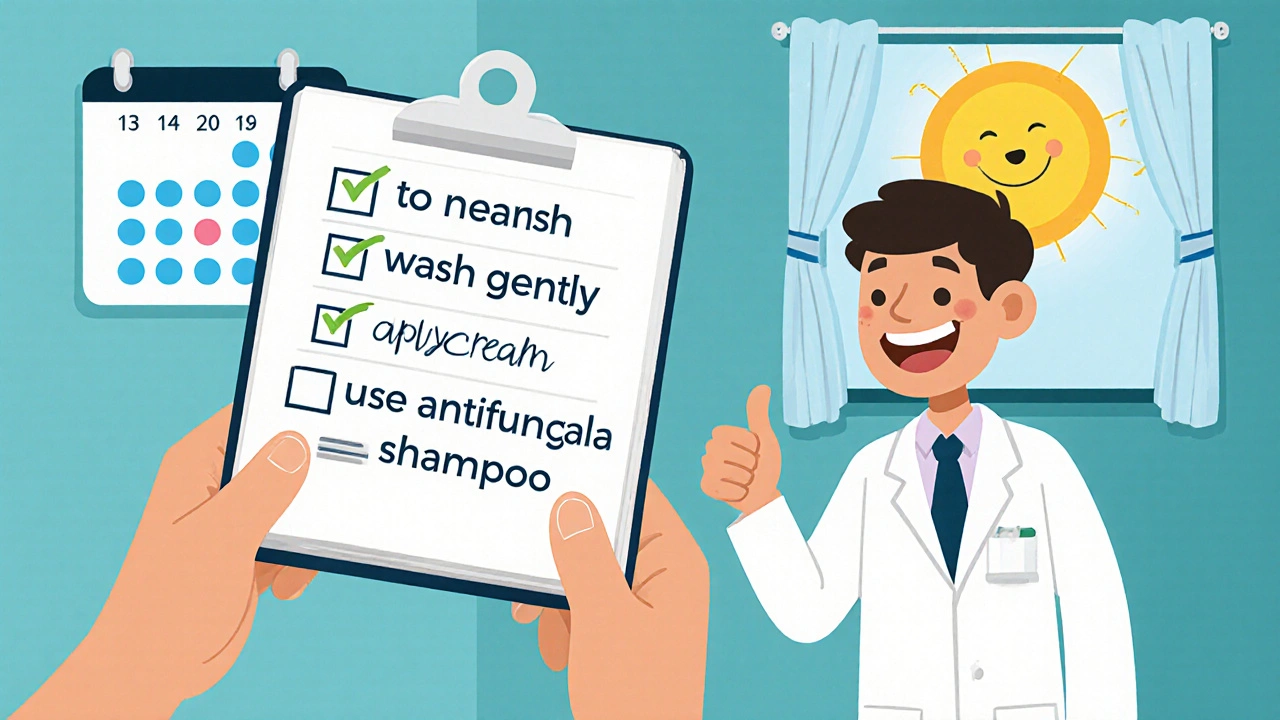When oily, flaky patches keep showing up on your scalp or face, it’s easy to wonder if you’ll ever find relief. hydrocortisone can be that simple, fast‑acting tool that brings the itch and redness down, but it works best when you understand why it helps and how to use it safely.
What is Seborrheic Dermatitis?
Seborrheic Dermatitis is a chronic inflammatory skin condition that mainly affects areas rich in sebaceous glands - the scalp, eyebrows, sides of the nose, ears, and chest. It presents as greasy, yellow‑white scales that itch or burn. The exact cause isn’t a single factor; instead it’s a mix of malassezia yeast overgrowth, immune response, and skin‑barrier dysfunction.
Why Hydrocortisone Works
Hydrocortisone belongs to the class of Corticosteroids that mimic the body’s own cortisol hormone. When applied topically, it reduces inflammation, eases itching, and shrinks the tiny blood vessels that make the rash look red. In the hierarchy of topical steroids, hydrocortisone is a low‑potency option (usually 0.5%‑2.5%). That makes it a safe first‑line choice for mild‑to‑moderate seborrheic patches, especially on sensitive areas like the face.
Choosing the Right Formulation
Not all hydrocortisone products are created equal. The medication comes in creams, ointments, gels, and lotions, each with a slightly different skin‑feel and absorption profile.
- Cream is lightweight, non‑greasy, and ideal for the face or scalp where you don’t want a heavy residue.
- Ointment contains a petroleum‑based base, locking moisture in. It’s best for dry, cracked patches but can feel oily.
- Gels dry quickly and are good for oily skin, though they may sting if the skin is very inflamed.
- Lotions spread easily over large areas like the chest or back.
For most people dealing with scalp or facial seborrheic dermatitis, a 1% hydrocortisone cream strikes a good balance between effectiveness and comfort.
How to Apply Hydrocortisone Properly
- Wash the affected area with a gentle, fragrance‑free cleanser. Pat dry - don’t rub.
- Apply a thin layer of the chosen hydrocortisone product. The amount should be enough to cover the rash without a thick film.
- Massage gently for 30 seconds to help absorption.
- If you’re treating the scalp, consider using a small amount of cream, then distributing it with a soft brush or your fingertips.
- Leave it on for at least 4 hours before washing off. Some doctors recommend a night‑time application.
- Limit use to 7‑14 days unless a dermatologist advises otherwise. Prolonged use can thin the skin.
After you finish the short course, keep a mild non‑prescription moisturizer handy to restore the skin barrier and reduce the chance of a flare‑up.
When to Combine Hydrocortisone with Other Therapies
Hydrocortisone tackles the inflammation, but the underlying yeast overgrowth often needs an antifungal partner. Typical combos include:
- Ketoconazole shampoo (2%): use twice a week on the scalp, leave for 5 minutes, then rinse.
- Zinc pyrithione (1%): useful for both scalp and facial areas; apply as a leave‑on solution.
- In stubborn cases, a dermatologist may prescribe a higher‑potency steroid (e.g., clobetasol) for a brief period, followed by a taper with hydrocortisone.
Always talk to a healthcare professional before layering medications, especially if you have sensitive skin or a history of eczema.
Potential Side Effects and How to Avoid Them
Because hydrocortisone is low‑potency, side effects are uncommon, but they can happen if you over‑use it.
- Skin thinning - more likely when used for >2 weeks on the same spot.
- Red‑spot rebound - the rash may flare up once you stop the cream suddenly; tapering helps.
- Acne or folliculitis - especially with ointments on oily skin.
To keep risks low: stick to the recommended duration, rotate application sites if you need longer treatment, and give your skin a break with a moisturizer or a fragrance‑free barrier cream.
Special Considerations for Different Age Groups
Children: Pediatric skin is thinner, so a pediatric‑formulated 0.5% hydrocortisone cream is preferred. Apply only a thin layer once or twice daily for up to a week.
Pregnant or breastfeeding individuals: Hydrocortisone is classified as FDA Category C, but short‑term topical use is generally considered safe. Still, consult your OB‑GYN before starting.
Elderly: Aging skin loses elasticity; a moisturizer underneath the steroid can prevent dryness and cracking.
When to See a Dermatologist
If any of the following apply, schedule a professional appointment:
- Rash spreads to new areas despite over‑the‑counter treatment.
- There’s bleeding, oozing, or crusting.
- You need treatment on the genitals or other sensitive mucosal zones.
- Symptoms persist beyond three weeks after a full course of hydrocortisone.
A dermatologist can confirm the diagnosis, rule out psoriasis or fungal infections, and tailor a regimen that may include oral medications or phototherapy.

Comparing Common Over‑the‑Counter Hydrocortisone Products (2025)
| Brand | Strength | Formulation | Typical Price (AU$) | Best Use |
|---|---|---|---|---|
| Cortizone-10 | 1% | Cream | 9.99 | Facial or scalp mild flare |
| Hydro‑Care | 0.5% | Ointment | 7.50 | Dry, cracked patches |
| Dermalin | 2.5% | Gel | 12.00 | More stubborn inflammation (short‑term) |
These prices reflect typical Australian pharmacy listings in October 2025. Choose the lowest strength that eases symptoms to minimize side effects.
Quick Checklist Before You Start
- Identify the affected areas and severity.
- Pick a low‑potency hydrocortisone (0.5%‑1%) cream or ointment.
- Wash and dry the skin gently.
- Apply a thin layer once or twice daily for up to 14 days.
- Pair with an antifungal shampoo if the scalp is involved.
- Monitor for skin thinning, rebound flare, or acne.
- Stop after the recommended course or consult a dermatologist if symptoms linger.
Frequently Asked Questions
Can I use hydrocortisone on my scalp daily?
Yes, a thin layer of 1% cream applied once a day is safe for up to two weeks. Rotate with an antifungal shampoo to keep the yeast in check.
Is hydrocortisone safe for children?
For kids, use a pediatric‑strength 0.5% cream, limit application to once or twice daily, and never exceed seven days without a doctor’s advice.
What’s the difference between cream and ointment?
Creams are water‑based, absorb quickly, and feel light-good for the face. Ointments are oil‑based, stay longer on the skin, and lock in moisture-better for dry, cracked patches.
Will hydrocortisone cure seborrheic dermatitis?
It controls the inflammation and itch, but the condition often recurs because the underlying yeast and oil production remain. Ongoing scalp care and occasional low‑dose steroids keep it at bay.
Can I combine hydrocortisone with other skin products?
Yes, but wait 5-10 minutes after applying hydrocortisone before layering moisturizers or sunscreen. This avoids diluting the steroid’s effect.
Next Steps If You’re Still Unsure
Grab a small tube of 1% hydrocortisone cream from your local pharmacy, follow the short‑term plan above, and keep a diary of where the rash appears and how it responds. If the diary shows no improvement after ten days, book a spot with a dermatologist and bring the notes along. That way you’ll get a targeted prescription-maybe a stronger steroid or a different antifungal-without wasting time on guesswork.
Remember, seborrheic dermatitis is common (affects up to 5% of adults), and most people find relief with the right mix of gentle steroids and good scalp hygiene. With a little patience and the right product, you can ditch the flakes and feel confident again.


Comments (10)
Pamela Clark
I remember the first time I tried a “miracle” cream that promised to banish every flaky demon on my scalp.
The label read like a love letter to the dermatologist’s ego and I, ever the skeptic, rolled my eyes.
Yet the itching persisted like an unwanted houseguest, so I gave in to the seductive promise of hydrocortisone.
The moment the cool cream touched my skin I felt a fleeting sense of triumph as if I had finally outwitted nature.
It was, of course, a fleeting victory; the inflammation receded only to return with a vengeance when I dared to stop.
The article’s gentle reminder to limit usage to two weeks feels almost like a parental lecture to a rebellious teenager.
But let us not forget that the real villain here is the overproduced sebum, a greasy empire that refuses to surrender.
Hydrocortisone, in its low‑potency glory, is merely a diplomatic envoy sent to negotiate a cease‑fire.
When applied correctly-thin layer, gentle massage, and a respectful four‑hour waiting period-it performs its duties with modest grace.
The choice of formulation, be it cream, ointment, gel, or lotion, is akin to selecting the proper attire for a climate‑specific soirée.
For oily scalps the gel shines like a sleek tuxedo, whereas the ointment drapes the dry patches in a velvet cloak.
The author’s checklist at the end reads like a bureaucrat’s to‑do list, yet it is invaluable for the chronically indecisive.
Pairing the steroid with an antifungal shampoo is not merely optional, it is a strategic alliance against the candida‑like insurgents.
In my humble opinion, the only tragedy would be to abandon the moisturizer after the steroid course, for that is where the skin barrier truly regains its sovereignty.
So, dear sufferers, treat this guide as a map-follow the routes, respect the boundaries, and you might just locate the oasis of flake‑free peace.
And remember, no topical miracle will replace the basic virtues of patience, hygiene, and perhaps a dash of humility.
Diane Holding
Great overview! Stick to the thin layer rule and you’ll avoid most side effects. Pairing with a gentle shampoo can keep the yeast under control. Remember to moisturize after the course ends.
Manish Verma
From down under we’ve learned that a good sunscreen and a proper steroid routine keep the scalp clear. Hydrocortisone works well when you don’t over‑apply – Aussie skin can be tough but it still reacts. Use the cream on the face, the gel for oily zones. Keep the course short and you’ll avoid thinning. Cheers!
Lionel du Plessis
Hydrocortisone lowpotency ideal for seborrheic patches minimal irritation high efficacy especially when combined with ketoconazole shampoo synergy improves outcomes
Greg Galivan
Look here you cant just slather any cream on your face its not rocket scince hydrocortisone works but overuse leads to thinning skin watch out dont be lazy
ALBERT HENDERSHOT JR.
Indeed, moderation is key. Applying a thin layer once or twice daily respects the skin’s natural barrier while providing relief. Pair this with a moisturizer to promote healing 😊. Consistency over the recommended period yields the best results.
Kala Rani
Honestly the guide oversells the cream its just a steroid not a cure all
Donal Hinely
Ah but the drama of a flaky scalp is like a wild fire in a summer night-glorious yet terrifying. Smash that inflammation with a bold splash of cream, then tame the embers with a fragrant shampoo. Let the colors of clear skin burst forth!
christine badilla
My scalp was a desert of flakes until I dared to try this.
Octavia Clahar
Sounds like you’ve found your oasis-keep the routine gentle and the skin will thank you. Just remember not to overdo it, darling.